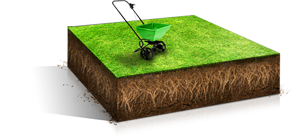If you often read about Tulsa lawn care tips and maintenance, you may have wondered about terms like “core aeration,” “overseeding,” and “dethatching.” Even knowing what lawn fertilization really includes can sometimes be a challenge. Today we’ll hopefully clarify these lawn care terms a little more, as well as offer some helpful tips on how to best handle these different aspects of turf care.
Core aeration. This lawn care process can from time to time be called coring, aerating, or aerifying. During aeration, small plugs of soil and dead grass, or thatch, are removed to relieve compacted soil. Soil compaction is frequently more of a problem in high traffic areas or where heavy machinery has been used. Over time and without enough nutrients, soil can become compressed and not allow for adequate drainage. Without proper drainage and enough oxygen, the root system will be superficial and the lawn weak. The small holes made during aeration permit more water, air, and nutrients to reach the roots, helping them to grow deeper and stronger, creating a healthier and more beautiful lawn.
How to aerate. For cool-season grasses, the best time for core aeration is in late summer or early fall, and for warm-season grasses the best time is late spring. For problematic lawns and those with heavy traffic, you may want to aerate the lawn every year or so, but for lawns without many soil compaction problems, aerating every several years is good. You can often rent a mechanical core aerator at your local lawn and garden store, or Oklahoma Landscape in Tulsa can handle all of your aeration needs.
Dethatching. Thatch is dead grass, stems, leaves, and other organic material that collect just above the soil. This thatch will look like a tightly woven layer of debris. While some thatch is good for the lawn, too much will create a barrier and will prevent proper drainage and prevent oxygen and nutrients from reaching the root system. Too much will also allow for more insects and disease. Thatch should be able to naturally decay, but sometimes there can be an excess of thatch that can severely harm the lawn. More than about ½ inch of thatch is too much for your lawn to be healthy.
How to dethatch. Aerating the soil is usually the best way to dethatch because while eliminating the thatch, it also relieves soil compaction. If you would like to just dethatch, you can rent a power rake or a vertical mower. A vertical mower is frequently better for the lawn because it cuts grooves into the thatch and then pulls them up without pulling up too much grass. Like aerating, the best time to dethatch will depend on your type of grass variation. Mow your grass slightly shorter before detaching. When the thatch is pulled up, rake the thatch and remove it from the lawn.
 Overseeding Tulsa lawns. This is the process of planting new grass seeds over the existing turf to fill in bare or thinning spots of grass. This is sometimes called reseeding or just seeding your lawn. Overseeding is needed because over time or with the intense heat of summer, lawns can begin to become bare or overrun with weeds. Seeding your lawn with new grass, especially new varieties of grass, will help it be more resilient and more resistant to disease, drought, insects, and weeds. Planting these new grass seeds over existing turf can really help to improve the condition of your lawn, making it more vibrant and thicker.
Overseeding Tulsa lawns. This is the process of planting new grass seeds over the existing turf to fill in bare or thinning spots of grass. This is sometimes called reseeding or just seeding your lawn. Overseeding is needed because over time or with the intense heat of summer, lawns can begin to become bare or overrun with weeds. Seeding your lawn with new grass, especially new varieties of grass, will help it be more resilient and more resistant to disease, drought, insects, and weeds. Planting these new grass seeds over existing turf can really help to improve the condition of your lawn, making it more vibrant and thicker.
How to overseed your lawn. There are a few steps to overseeding your lawn including preparing the ground, choosing a good seed variety, spreading the new seeds, and fertilization and watering. Check out our blog post about How to Overseed your Tulsa Lawn this Spring for tips on how to overseed your lawn most effectively. A part of the overseeding process may also include aerating the soil to allow the new seeds to grow correctly.
Lawn fertilization in Tulsa. Fertilizers deliver food to your lawn, particularly nitrogen, phosphorus, and potassium to aid the lawn in building strong roots. Lawns need regular fertilization to be healthy. Slow-release fertilizers are best because they feed the lawn over time.
How to fertilize. During about every season, Tulsa lawns can use a good lawn fertilization treatment, depending on the type of grass you have. A combination fertilizer and weed control treatment can help to avert the spread of weeds while feeding the grass. There are organic fertilizers like compost or corn gluten you can use also. See our article, Lawn Fertilization in Tulsa – Tips for a Green, Lush Lawn, for more information on fertilizing.
Keep in mind that the Tulsa lawn care experts at Oklahoma Landscape can take care of all your lawn care and maintenance needs, giving you a beautiful, hassle-free lawn this summer.
